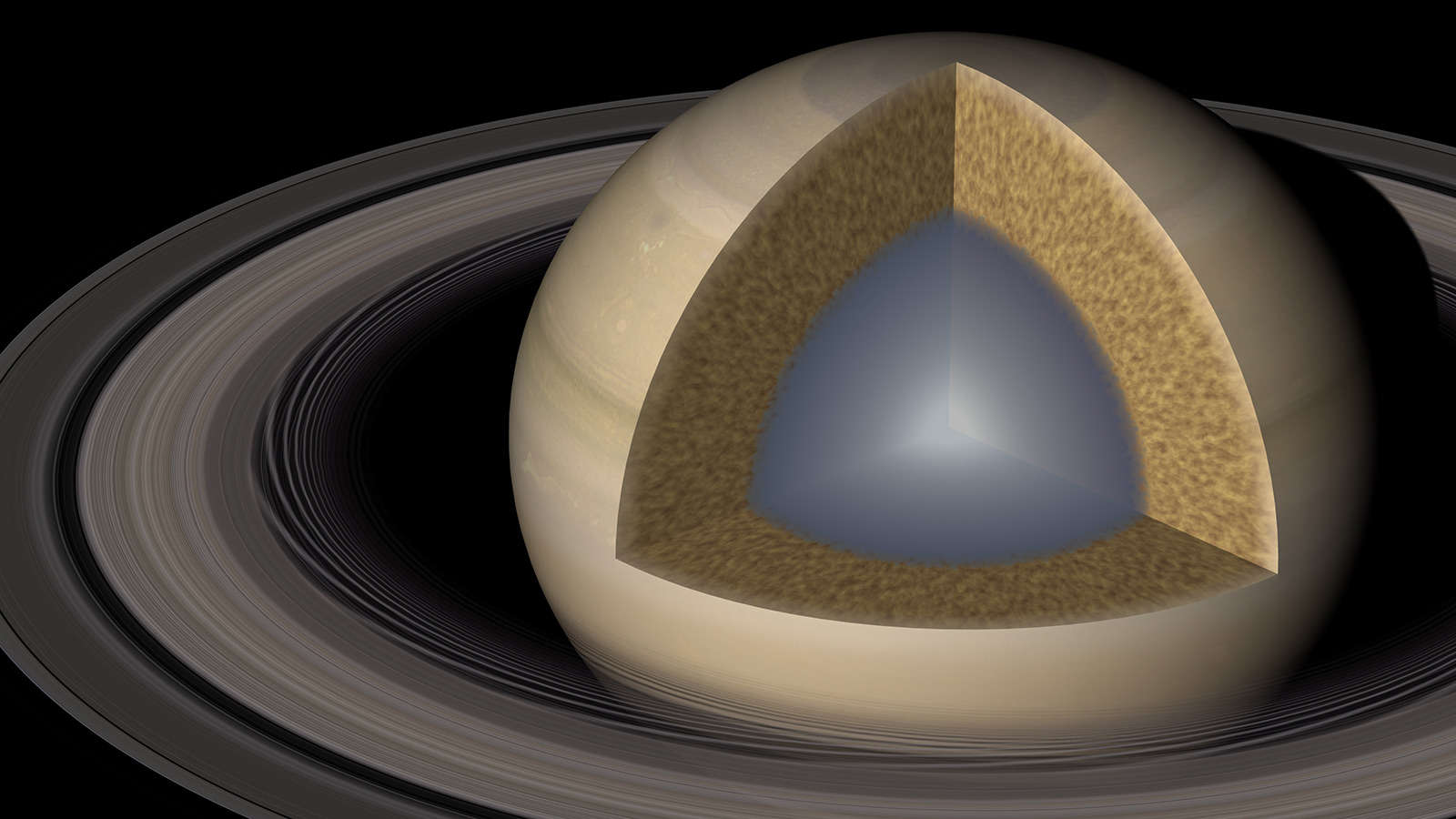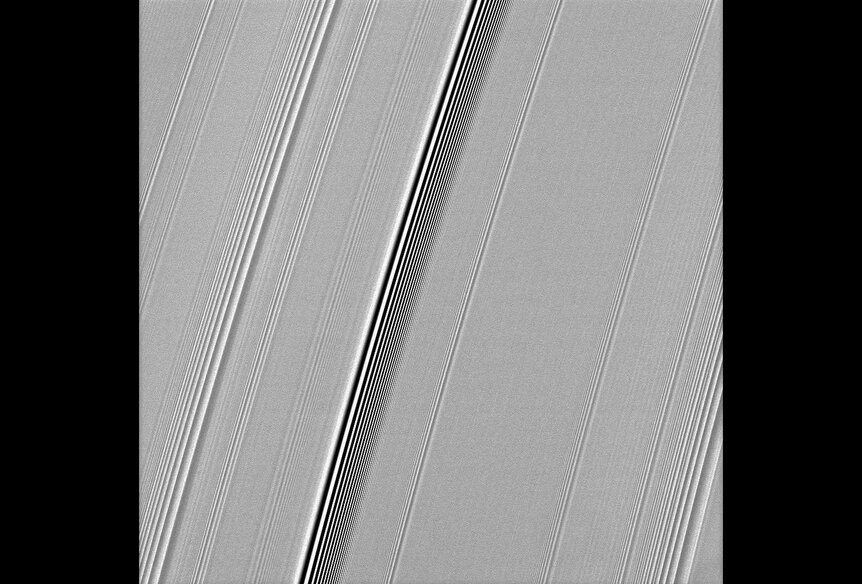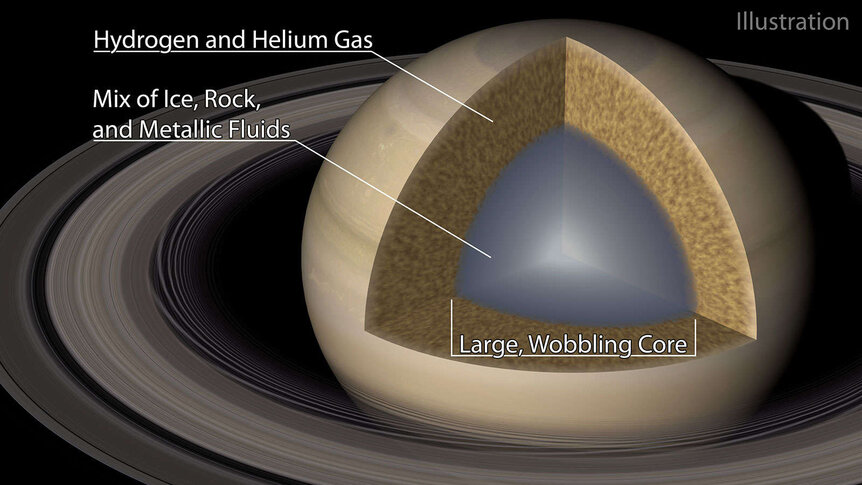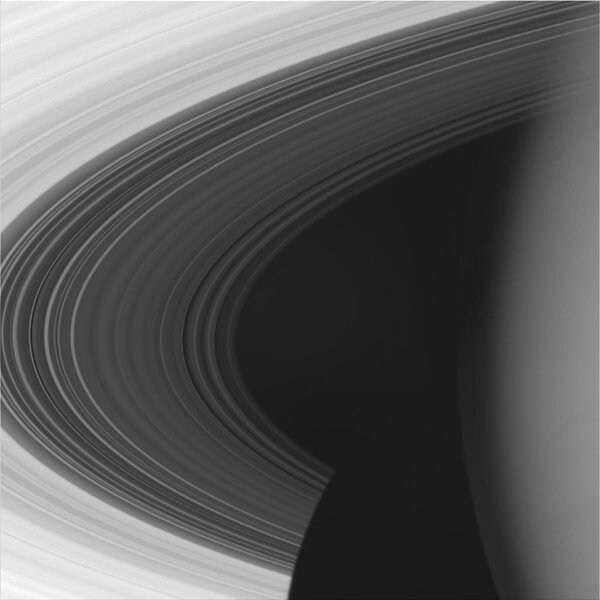Create a free profile to get unlimited access to exclusive videos, sweepstakes, and more!
Saturn's core is big and fuzzy — and its gravity is written in the rings

Saturn's rings are the most magnificent and exquisitely shaped structures in the solar system. And, it turns out, they make an excellent gravitational seismograph to determine what's going on inside the planet itself.
Although not connected physically, the planet and rings are connected gravitationally.
New work analyzing images of Saturn's rings show that waves in the rings are created by changing gravity from Saturn's core as it sloshes around inside the planet like a bag of jelly, and which is also far larger and structured differently than previously thought.
Previous models indicated Saturn's core was likely small and dense, but these new results show that it's likely huge and fuzzy, with no sharp boundary, and extends out to an incredible 60% of Saturn's radius — nearly 35,000 km, making it five times wider than the entire Earth. It has 17 times Earth's mass just in rock and ice, and something like 38 times Earth's mass in gas mixed in as well.
A reminder, if you needed one, that Saturn is huge.
These surprising results come from a close examination of Saturn's rings. For example, gravitational interactions with the moons carve gaps in the rings, some large and easily visible from Earth, but most (thousands of them) so small they weren't observed until the Cassini spacecraft observed them during its 13-year-long mission orbiting Saturn.
The two main rings you see in images are the A and B rings, but fainter and closer in to Saturn is the C ring. It's over 17,000 km wide but only about 5 meters thick, and a little difficult to see from Earth, but Cassini was right there, and took thousands of images of it. Planetary scientists were surprised to find a spiral wave pattern in the C ring that could not be explained by the tug of Saturn's fleet of moons, and they realized that these waves could be generated by Saturn itself.
When you have a ball of fluid, waves can move along the surface, similar to how ripples move across water in a bathtub. This compresses the material in some places and expands it in others, and that affects the gravity felt by particles in the rings. If gravity increases slightly in one spot deep inside Saturn, a bit of ice in the rings will travel more rapidly as it approaches it and slows when it passes. This creates what's called a spiral bending wave in the rings, changing the pattern of the rings.
Cassini saw these kinds of ripples in the C ring. The exact wavelength of the ripples (the distance between successive crests in the density of the ring particles) is extremely sensitive to what's going on inside Saturn — the motions are governed by the rules of spherical harmonics, a complicated set of equations that the scientists took advantage of to create models of the planet's interior to see what could make these waves.
They ran different models, allowing the core to range in size from very small to essentially the size of Saturn itself, and crucially they also allowed the material in the core to change, adding in different amounts of helium and heavier materials like rock and ice.
What they found is that the best fit to the data shows a big, diffuse core. It doesn't have a sharp edge like Earth's core, but instead is fuzzy, blurring into the outer gaseous hydrogen envelope. They also found it sloshes around, a little bit like water in a bathtub or pool in an earthquake. It's these motions that sculpt the rings tens of thousands of kilometers above.
Why is the core so huge and fuzzy? That has to do with its composition; it's not just ice and rock, but has a vast amount of hydrogen and helium gas mixed in as well. Previous models supposed the core was made up of layers distinguished by composition (like a lasagna), but this new one shows it's more of a gradient, smoothly changing in composition with distance from the center of the planet.
The effects of this are profound. A compositional gradient prevents the core from convecting, meaning hot material doesn't rise, cool, and sink back to the center. Convection is an efficient way of getting rid of central heat (it's what causes hot air to rise in Earth's atmosphere, and water to rise and fall when you boil it in a pot), but it looks now like Saturn's core can only rid itself of heat by diffusion, a much slower and inefficient process. This is actually good news; Saturn is much warmer in its interior than the older models suggest it should be, but this new model explains it naturally.
It also means Saturn's magnetic field is generated differently than thought, too. Convection, coupled with the planet's rapid rotation, generates what's called a dynamo, where moving material creates a magnetic field. If Saturn's core isn't convecting, that means the powerful magnetic field is generated in some other way. It's possible there is some weak layering in the core, and the material in the layers is convecting, just not over the entire depth of the core.
It also has implications for how Saturn originally formed over 4.5 billion years ago. One idea is that it underwent core accretion, where material rapidly consolidated into a dense core, which then pulled in gas from the material around it. But in that case it shouldn't be mixed with so much gas as the new model indicates it does.
Another idea is called pebble accretion, where it formed more slowly from small bits, which can make a larger, less compact core that can be mixed with a sizeable amount of gas. The new data leans more toward that idea, though the scientists mention that it may have formed with a more distinct core that somehow became more diffuse later.
Jupiter has a fuzzy core, too, and that could be explained by pebble accretion. It's also possible it underwent a huge head-on impact with a planetary-sized body early on that mixed it up and made it more diffuse. The scientists in the new paper don't think this is likely with Saturn, however.
This whole thing fills me with awe. A subtle spiral pattern in a faint collection of trillions of icy particles orbiting above Saturn leads to a new model of the core, making it larger, fuzzier, sloshier, and just plain weirder than thought, which also has implications for how Saturn makes its magnetic field, how it sheds heat, and even how the enormous planet formed in the first place.
If you go outside shortly after sunset tonight when the sky gets dark, Saturn is a lovely yellowish bright “star” in the southeast. You can see the rings even through binoculars, and a telescope shows Saturn as the wondrous jewel of the solar system that it is. And as gorgeous and amazing as this planet appears, more amazing yet is that we still have so much to learn about it... and that we can learn about it.
And that is one of my favorite things about it.





























